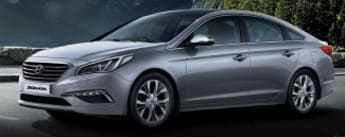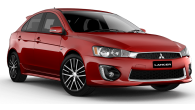It turns out few of us aspire to own a regular sedan these days because, well, they're seen as passé.
Sales of medium-size sedans are falling – down by 40 per cent over the past seven years – as buyers embrace small cars and SUVs which are cheaper to buy, or offer more space and practicality for the money.
On top of that, small cars are better suited to congested cities while SUVs, according to marketing experts, tell the person in the car next to you "I can escape this mess if I want to" – even if they're in the same traffic jam as you. And also in an SUV.
Against these odds, car makers continue to invest billions of dollars in new models to win their share of the dwindling mid-size sedan market.

Why? Because if they can deliver a car that people want, it will deliver them a financial windfall.
Mid-size cars don't cost much more to manufacture than small cars – but sell for at least 50 per cent more.
Hoping to roll the dice and come up with a winner, Hyundai's new Sonata arrived in Australian showrooms this week.
It replaces the oddly named i45 that was axed two years ago and, just to confuse matters, revives the Sonata badge the car was originally sold here with 25 years ago.
Hyundai are trying to work their magic and claw back sales from the Toyota Camry
By Hyundai's own admission, the Australian medium passenger segment has proven "a very tough segment to crack".
"It's essentially divided into two parts, the locally manufactured Camry – and everybody else," says Hyundai product planner Andrew Tuitahi, who should know. He used to work for Toyota, helping turn the Camry into a winner.
Now he and Hyundai are trying to work their magic and claw back sales from the Toyota Camry, the top-selling medium-size car in Australia for the past 21 years in a row – and which accounts for almost half of all sales in the entire segment.
Hyundai is so determined to establish a stronghold in the medium-size car market it will maintain a two-pronged approach to try to tackle the Camry: it will continue to sell the European-sourced i40 sedan and wagon alongside the Sonata.
The difference: the i40 offers buyers the choice of a diesel engine and a wagon body style (sales of which are growing in a declining segment) while the Sonata has a choice of a basic 2.4-litre four-cylinder or 2.0-litre turbo petrol power.
Pricing starts from $29,990 plus on-road costs for the standard Sonata including six airbags, a rear-view camera, 17-inch alloy wheels and a 4.3-inch touchscreen with Bluetooth phone and audio connectivity.
The 2.0-litre turbo starts from $36,990 plus on-road costs and adds a zippier – and thirstier – engine, as well as leather upholstery, 12-way electric adjustment for the driver's seat (what happened to forward and back and up and down?), 8-inch touch screen with navigation (and three years' free map upgrade) and dual zone air-conditioning.
The $41,990 flagship gains 18-inch alloy wheels, a panorama sunroof, high intensity headlights, heated and cooled seats, rain sensing wipers, electric adjustment for the front passenger seat, heated side mirrors (so they don't frost in winter), front parking sensors (to join those on the rear of the other two models), rear door sun blinds, the list goes on.
Behind the wheel
According to Hyundai's tape measure, the new Sonata is wider and taller than the Camry and has a longer wheelbase (the distance between the front and rear wheels) than the category's top-seller.
The front seat occupants have more leg room than a Camry
This gives the Sonata a generous footprint, which is better for road holding, while at the same time giving everyone inside more elbow room.
The front seat occupants have more leg room than a Camry and even a Holden Commodore; back seat passengers also have more headroom than the Camry and Commodore.
The ace up the Sonata's sleeve? It has a massive boot, although 5 litres smaller than a Camry's, at 510 litres in capacity it has 14 litres more cargo room than a Holden Commodore.
On the media preview drive on the winding mountain roads of Tasmania we started in the $29,990 model powered by the 2.4-litre four-cylinder engine.
A relatively smooth and fuss free operator, it sounds loud from the outside but there must be ample insulation because it is quiet inside.
The engine delivers a modest amount of power but it's more than enough for commuter driving.
It has ample urge without having to floor the accelerator
The suspension doesn't jar over bumps but, when pushed, the car feels like it wants to run wide.
Perhaps it was the 17-inch Nexen tyres because the next model we tried was powered by the 2.0-litre turbo engine and ran Hankook tyres. They tended to offer slightly better grip and steering feel.
The 2.0-litre turbo engine itself is a powerhouse, it's just a pity there is a $6000 price premium to experience one.
It has ample urge without having to floor the accelerator, and isn't noisy. It would be the pick of the two engines except for one caveat: it's thirsty. In fact both engines are thirstier than their rivals from Toyota, Mazda and Subaru.
Hyundai Sonata 2015: Active
| Engine Type | Inline 4, 2.4L |
|---|---|
| Fuel Type | Unleaded Petrol |
| Fuel Efficiency | 8.3L/100km (combined) |
| Seating | 5 |
| Price From | $9,680 - $13,310 |
| Safety Rating |
|
Verdict
Hyundai has created another competent car with the new Sonata, and it's reasonably well equipped for the price. But it remains to be seen if it will lure buyers back into the mid-size sedan segment – or if the mass migration to small cars and SUVs will continue.
Pricing Guides

.jpg)
.jpg)
.jpg)
.jpg)
.jpg)
.jpg)
.jpg)
.jpg)
.jpg)
.jpg)
.jpg)
.jpg)
.jpg)
.jpg)


.jpg)














.png)

.jpg)
.jpg)
.jpg)



